You’ve probably noticed how Louisiana’s landscapes shift dramatically from cypress-draped swamps to sprawling oak hammocks, but you might not realize these aren’t random plant communities. Each native species has evolved specific survival strategies over thousands of years, creating intricate partnerships that keep these wetlands and woodlands thriving. When you understand which plants anchor these ecosystems—and why they’re irreplaceable—you’ll discover the hidden blueprint that determines whether restoration projects succeed or fail.
Contents
- 1 Louisiana’s Unique Ecosystem Challenges
- 2 Louisiana’s Native Blooming Beauties
- 3 Louisiana’s Towering Forest Guardians
- 4 Resilient Native Shrub Varieties
- 5 Selecting the Right Native Plants for Your Garden
- 6 Frequently Asked Questions
- 6.1 What Are the Legal Requirements for Removing Native Plants From Public Lands?
- 6.2 How Do Native Louisiana Plants Affect Local Property Values?
- 6.3 Which Native Plants Are Considered Invasive in Neighboring States?
- 6.4 What Permits Are Needed to Sell Native Louisiana Plants Commercially?
- 6.5 How Do Native Plants Impact Septic Systems and Underground Utilities?
Louisiana’s Unique Ecosystem Challenges
While most states face typical environmental pressures, Louisiana’s ecosystem battles a perfect storm of challenges that’d make any botanist lose sleep. You’re looking at wetland loss rates hitting 130 square kilometers yearly, with coastal marshes disappearing at football-field-per-hour speeds. Canal construction alone accounts for 50% of marsh destruction.
Rising sea levels and saltwater intrusion wreak havoc on freshwater plant communities. Invasive nutria create massive “eat-outs,” destabilizing soil through aggressive browsing. These combined pressures test ecosystem resilience like nowhere else.
Understanding these challenges becomes essential when you’re planning wetland restoration projects or choosing native plants for your Louisiana landscape. Without restoration efforts, projections indicate near-total loss of coastal wetlands by 2100.
Louisiana’s Native Blooming Beauties
Louisiana’s diverse native flowering plants offer year-round beauty while supporting local wildlife. From berry-producing shrubs to pollinator-friendly wildflowers, aquatic lilies, climbing vines, and flowering trees. These hardy species are naturally adapted to heat, humidity, and the region’s high rainfall conditions.
Louisiana Iris (Iris Fulva)
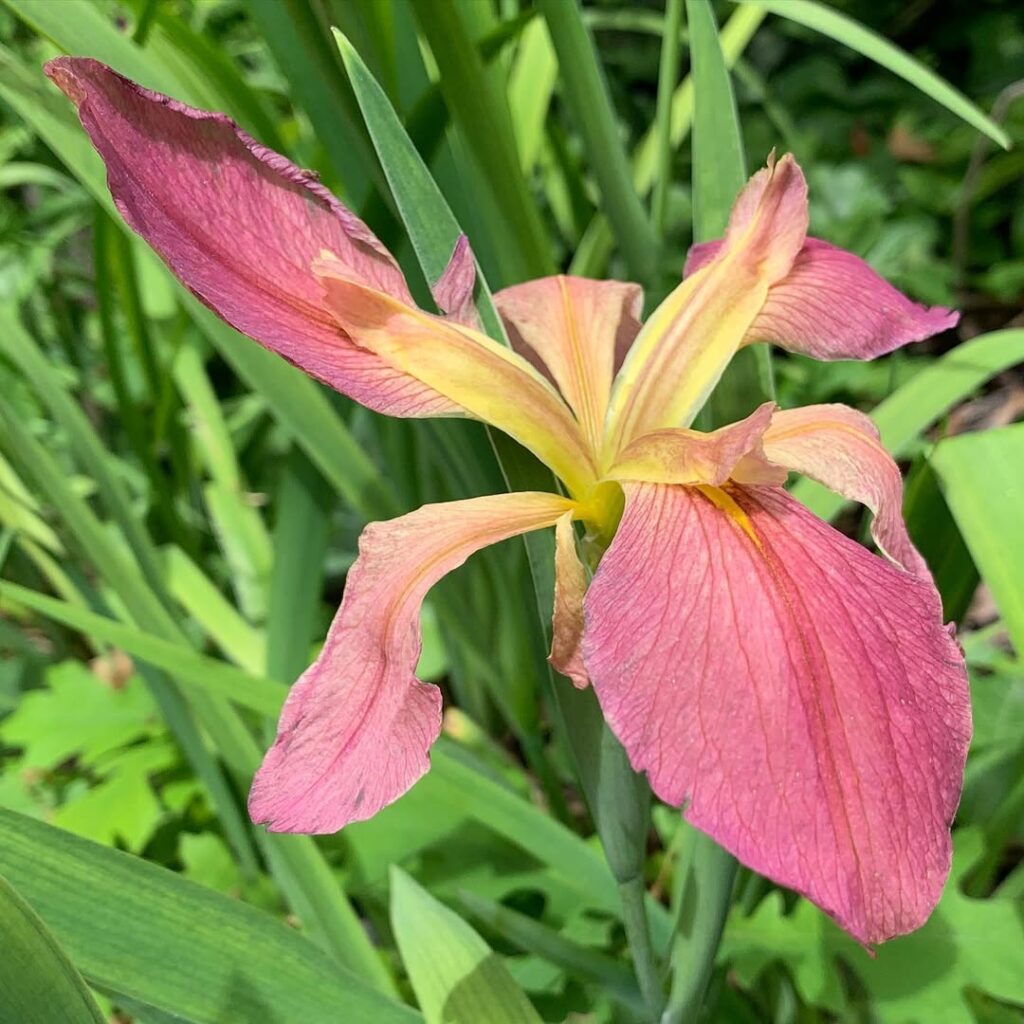
The Louisiana Iris (Iris fulva), commonly known as copper iris, is a distinctive native wetland plant featuring unique flat-topped, copper to terra cotta-colored flowers that bloom in late spring. This beardless iris grows 2-3 feet tall with bright green, sword-shaped leaves and is primarily pollinated by hummingbirds. Native to swamps, wetlands, and floodplains throughout the Deep South and lower Mississippi Valley, it plays an essential ecological role in Louisiana’s wetland ecosystems. This species was historically documented by John James Audubon in 1821, highlighting its significance in American natural history.
This remarkable iris thrives in consistently moist to wet conditions, tolerating up to 6 inches of standing water while also being drought tolerant once established. Though listed as endangered or threatened in some northern parts of its range due to habitat loss and agricultural runoff, it offers outstanding ornamental value with minimal pest issues and reliable perennial performance in its native climate.
- Hardiness: USDA zones 6-9, native to Deep South and lower Mississippi Valley
- Light: Full sun to part shade (part shade preferred in southern regions)
- Water: Consistently moist to wet; tolerates up to 6 inches of standing water
- Soil: Fertile, slightly acidic (pH 5.5-6.5), high organic matter; tolerates sand, loam, clay
- Fertilizer: Low maintenance; benefits from organic matter in soil
- Pest/Disease Resistance: Excellent; minimal pest and disease issues
- Growth Rate: Moderate; regenerates from roots after winter dormancy
Swamp Hibiscus (Hibiscus Moscheutos)
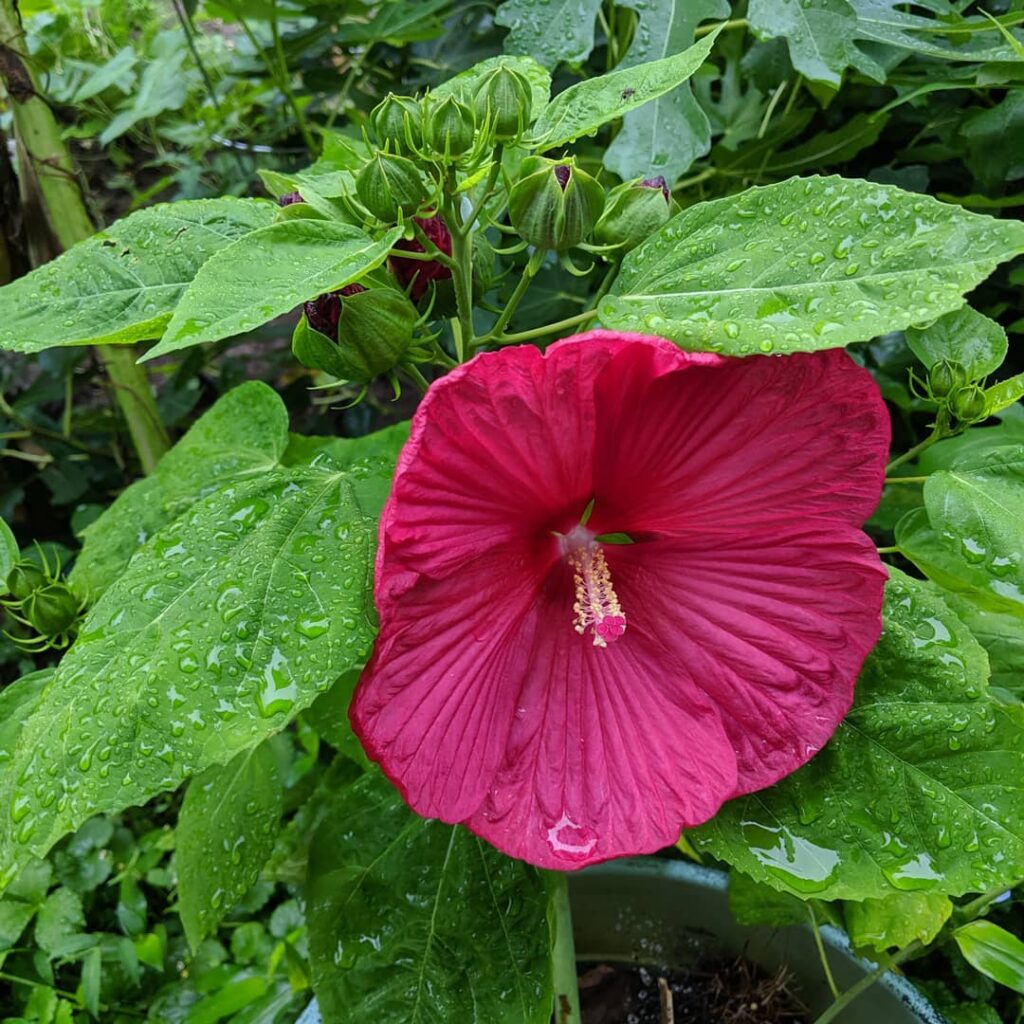
Swamp Hibiscus (Hibiscus moscheutos) stands as one of Louisiana’s most spectacular native wildflowers, creating dramatic displays throughout the state’s wetlands. This robust, shrubby perennial produces enormous saucer-shaped blooms up to 12 inches across, typically featuring pristine white petals with deep crimson centers that create stunning visual impact from mid-summer through early fall.
Native to Louisiana’s marshes, swamps, and wet prairies, this impressive plant grows 3-7 feet tall and forms extensive stands in suitable habitats. Each magnificent bloom lasts only a single day, but the plant produces flowers sequentially throughout the season, ensuring continuous color. As a member of the mallow family, Swamp Hibiscus shares botanical lineage with diverse plants including cotton and cacao, highlighting the remarkable adaptability of this plant group across different environments. Beyond its ornamental value, Swamp Hibiscus serves vital ecological functions, attracting pollinators, stabilizing wet soils, and supporting wetland biodiversity while thriving in conditions too challenging for most flowering plants.
- Hardiness: USDA Zones 5-8
- Light: Full sun to partial shade
- Water: Consistently wet to moist conditions; tolerates periodic flooding
- Soil: Poorly drained, wet soils; adaptable to both brackish and freshwater conditions
- Fertilizer: Low maintenance; thrives in natural wetland conditions without supplemental feeding
- Pest/Disease Resistance: Generally hardy with good natural resistance
- Growth Rate: Moderate to fast; forms large stands in suitable habitats
Spider Lily (Hymenocallis)

The Spider Lily (Hymenocallis liriosme) is a stunning native perennial that graces Louisiana’s wetlands with snowy-white flowers featuring distinctive yellow-green centers. Also known as Texas spider-lily or spring spiderlily, this bulb-forming plant produces fragrant blooms from March through August, creating spectacular displays along stream banks, marshes, and pond edges.
This obligate wetland species forms dense colonies through natural bulb multiplication, with narrow linear leaves and flowers that attract bees and moths. Beyond its ornamental value, Spider Lily provides important ecological benefits including erosion control through its dense root system and habitat for wetland wildlife. Known as “pancrais” in Cajun French, this resilient native is increasingly valued for wetland restoration and native garden projects. The species was originally described by botanist Constantine Samuel Rafinesque in 1817 in his work Florula Ludoviciana.
- Hardiness: USDA zones 7-10, cold-hardy perennial with persistent foliage in mild winters
- Light: Full sun to partial shade, tolerates varying light conditions in wetland settings
- Water: High water requirements, thrives in consistently moist to wet soils and shallow standing water
- Soil: Adaptable to various soil types but prefers rich, organic, waterlogged conditions typical of marshes
- Fertilizer: Low maintenance, benefits from organic matter in natural wetland settings, minimal fertilization needed
- Pest/Disease Resistance: Generally pest and disease resistant, well-adapted to native environment
- Growth Rate: Moderate growth rate, reaches 1-1.5 feet tall, spreads naturally through bulb division
Cardinal Flower (Lobelia Cardinalis)

Cardinal Flower (Lobelia cardinalis) is a stunning Louisiana native wildflower known for its brilliant scarlet red blooms that create spectacular displays along wetland edges and stream banks. This herbaceous perennial forms attractive basal rosettes of elliptical leaves and produces towering flower spikes that can reach 2-4 feet tall, making it one of the most eye-catching native plants in Louisiana’s landscape.
The plant’s tubular, two-lipped flowers are perfectly designed to attract ruby-throated hummingbirds, serving as a vital nectar source from mid-summer through early fall. Cardinal Flower plays an important ecological role in wetland ecosystems, stabilizing soil with its fibrous roots while providing habitat and food resources for various pollinators and wildlife. This resilient native plant also tolerates poorly drained clay conditions that challenge many other garden perennials.
- Hardiness: USDA Zones 3-9, well-suited to Louisiana climate
- Light: Full sun to part shade; prefers filtered light in harsh climates
- Water: High moisture requirements; thrives in consistently moist to wet soils
- Soil: Fertile, moist, well-draining soil; tolerates standing water and semi-flooded conditions
- Fertilizer: Low requirements; benefits from organic matter in planting area
- Pest/Disease Resistance: Generally resistant with good air circulation and proper moisture
- Growth Rate: Moderate; short-lived perennial that may self-seed under ideal conditions
Wild Bergamot (Monarda Fistulosa)

Wild Bergamot (Monarda fistulosa) is a striking native Louisiana perennial that brings both beauty and ecological value to the garden. This warm-season forb produces clusters of tubular, lavender-pink flowers from June through September, creating a magnet for bees and other pollinators. Growing 3-4 feet tall with distinctive square stems and aromatic foliage, wild bergamot has a rich history of medicinal and culinary use among Indigenous peoples.
The plant’s common names “beebalm” and “wild bergamot” reflect its exceptional ability to attract pollinators and its pleasant, bergamot-like fragrance. Its leaves can be harvested to make minty teas or used as seasoning, continuing traditional uses that span centuries. Wild bergamot thrives in Louisiana’s diverse habitats, from prairies to woodlands, making it an excellent choice for native plant gardens and naturalized landscapes. The flowers are excellent for cutting and make beautiful arrangements with their fragrant, long-lasting blooms.
- Hardiness: Zones 3-9, native to Louisiana
- Light: Full sun to part sun
- Water: Dry to medium moisture; drought tolerant once established
- Soil: Adaptable to various soils from sand to clay; prefers moist, organic, loose soil
- Fertilizer: Low maintenance; typically does not require fertilization
- Pest/Disease Resistance: Generally resistant; requires good air circulation to prevent issues
- Growth Rate: Moderate to fast; can spread aggressively via rhizomes
Louisiana’s Towering Forest Guardians
Louisiana’s forests showcase magnificent native trees that define the state’s diverse landscapes, from towering pines dominating commercial forestlands to majestic oaks anchoring historic avenues and wetland giants. The state’s Champion Tree program recognizes and documents these exceptional specimens, allowing residents to nominate trees for national recognition through the American Forests Big Tree directory.
Bald Cypress (Taxodium Distichum)
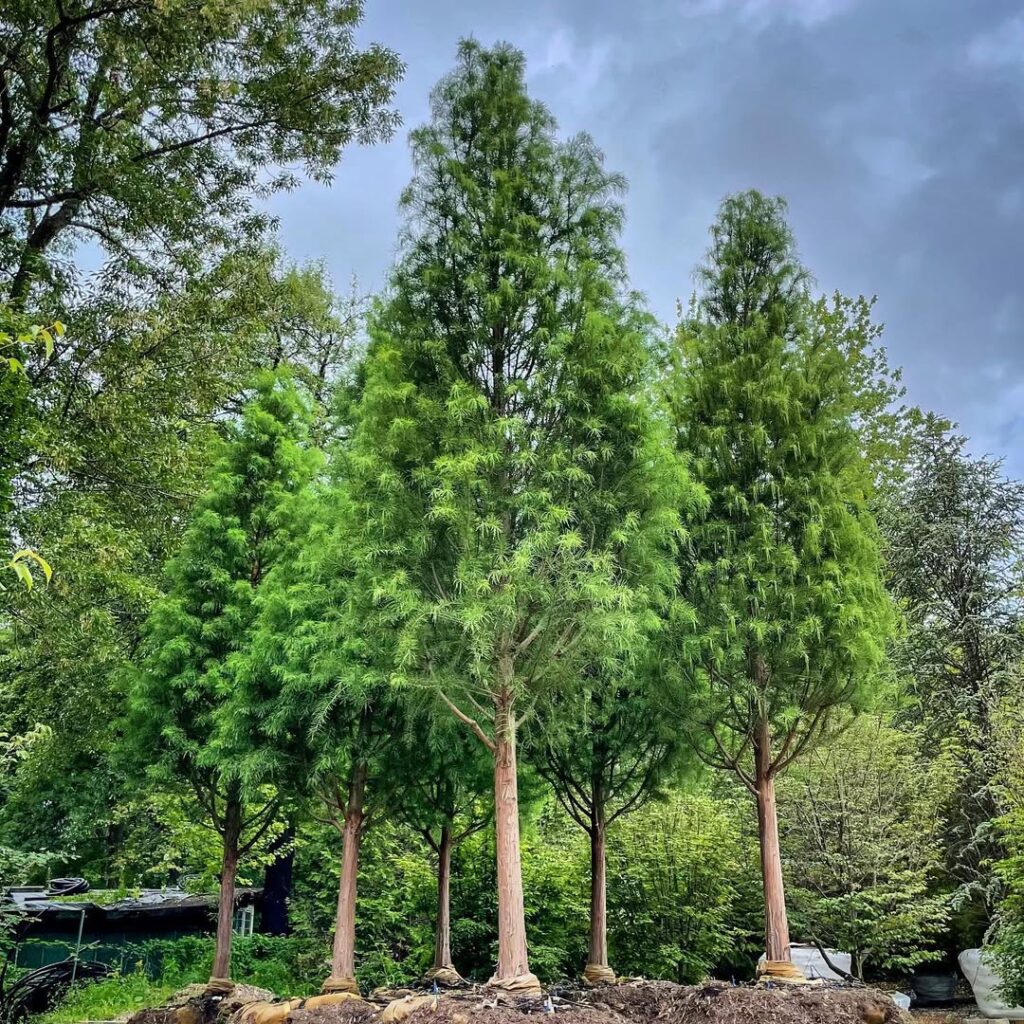
The Bald Cypress stands as Louisiana’s official state tree and an enduring symbol of the region’s wetland heritage. This deciduous conifer grows 50-70 feet tall with a distinctive fluted base and develops characteristic “knees” when growing in flooded conditions. Despite being a conifer, it sheds its russet-colored, needle-like leaves each fall, earning its “bald” designation.
Native to the southeastern United States and particularly prevalent in Louisiana’s river delta systems, the Bald Cypress demonstrates remarkable adaptability to diverse growing conditions. Its rot-resistant heartwood and longevity make it both ecologically and economically valuable, serving purposes from ornamental plantings to construction materials. The tree provides excellent erosion control along waterways, ditches, ponds, and lakes while supporting diverse wildlife populations.
- Hardiness: Zones 4-10, extremely hardy and long-lived
- Light: Full sun to partial shade
- Water: Highly adaptable from continuously flooded to moderately dry conditions
- Soil: Tolerates wide range including wet, dry, salty, or swampy soils
- Fertilizer: Low maintenance, typically requires no supplemental fertilization
- Pest/Disease Resistance: Generally resistant to most pests and diseases
- Growth Rate: Slow-growing but steady, developing into long-lived specimens
Live Oak (Quercus Virginiana)
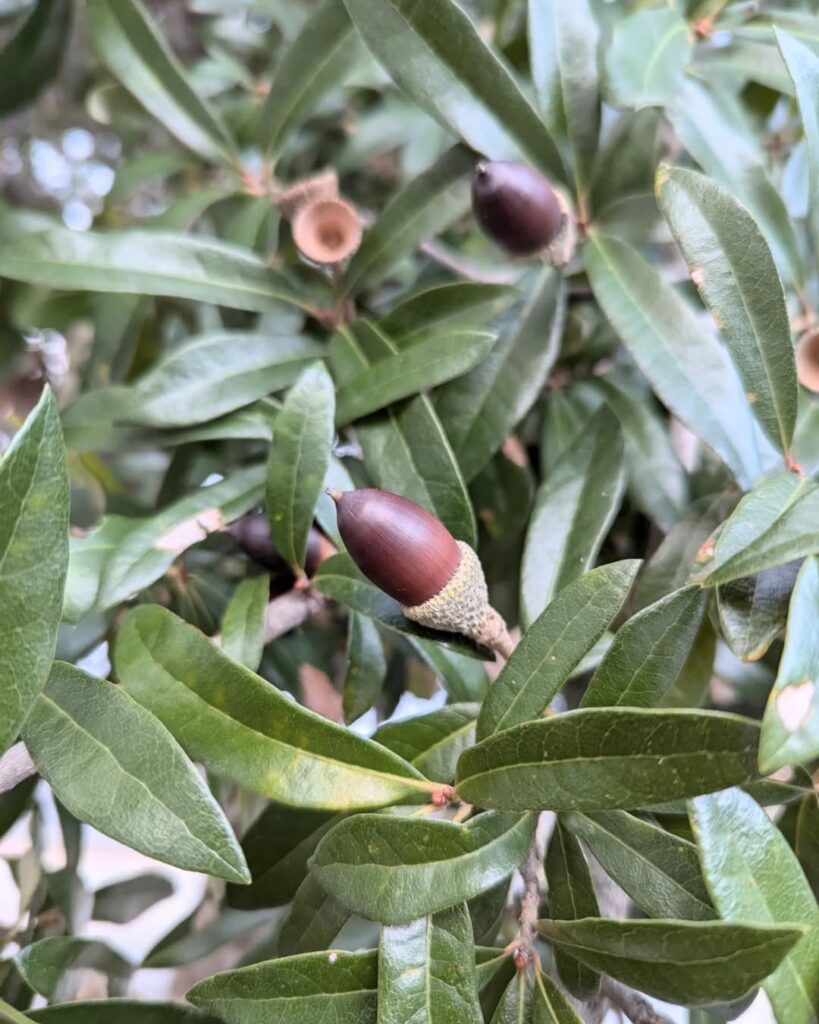
The Live Oak (Quercus virginiana) stands as one of Louisiana’s most magnificent native trees, distinguished by its massive, sweeping crown that can span over 150 feet. These majestic giants typically reach heights of 50 feet with trunk diameters averaging 3-4 feet, though some specimens grow much larger. Known for their distinctive broad, rounded canopy and horizontal branching pattern, Live Oaks are draped with Spanish moss and create iconic Southern landscapes.
These remarkable trees are celebrated for their exceptional longevity, often living several centuries while providing critical wildlife habitat and food through abundant acorn production. Live Oaks demonstrate remarkable resilience, withstanding strong winds and even thriving when growing at significant angles. Their dense, strong wood and deep root systems make them invaluable for soil stabilization and ecosystem support throughout Louisiana’s diverse habitats. The trees show exceptional fire-resistant qualities due to their ability to survive crown and root damage while their dense cover discourages flammable understory growth.
- Hardiness: USDA zones 8-10, native to southern Louisiana
- Light: Full sun to partial shade
- Water: Moderate; tolerates occasional flooding but not constant saturation
- Soil: Well-drained soils preferred; thrives in both moist and dry sites
- Fertilizer: Generally not required; benefits from organic mulch
- Pest/Disease Resistance: High resistance; very durable and long-lived
- Growth Rate: Rapid early growth, then steady long-term development
Sweetgum (Liquidambar Styraciflua)

Sweetgum trees are majestic native hardwoods that dominate Louisiana’s forests, reaching impressive heights of 60-100 feet with distinctive star-shaped leaves and spiky seed balls. These towering giants serve as ecological powerhouses, supporting numerous wildlife species from Luna moths to songbirds, while their fragrant resin has been valued since indigenous times.
Historically called “copal” by Louisiana’s Acadians, sweetgums have provided both practical and cultural value for centuries. Their strong hardwood ranks as the region’s second most common timber species, used for furniture and veneer, while the aromatic storax resin continues to serve medicinal and commercial purposes. These adaptable trees contribute significantly to soil stabilization in Louisiana’s varying terrain and wetland areas.
- Hardiness: USDA Zones 5-9, well-adapted to southeastern climates
- Light: Full sun to partial shade, prefers at least 6 hours direct sunlight
- Water: Adaptable from wet to moderately dry conditions, tolerates flooding
- Soil: Thrives in various soil types, prefers rich, moist, well-draining soils
- Fertilizer: Generally unnecessary in native settings, benefits from organic matter
- Pest/Disease Resistance: Generally hardy with few serious pest or disease issues
- Growth Rate: Moderate to fast, approximately 1-2 feet per year when established
Tupelo Gum (Nyssa Aquatica)
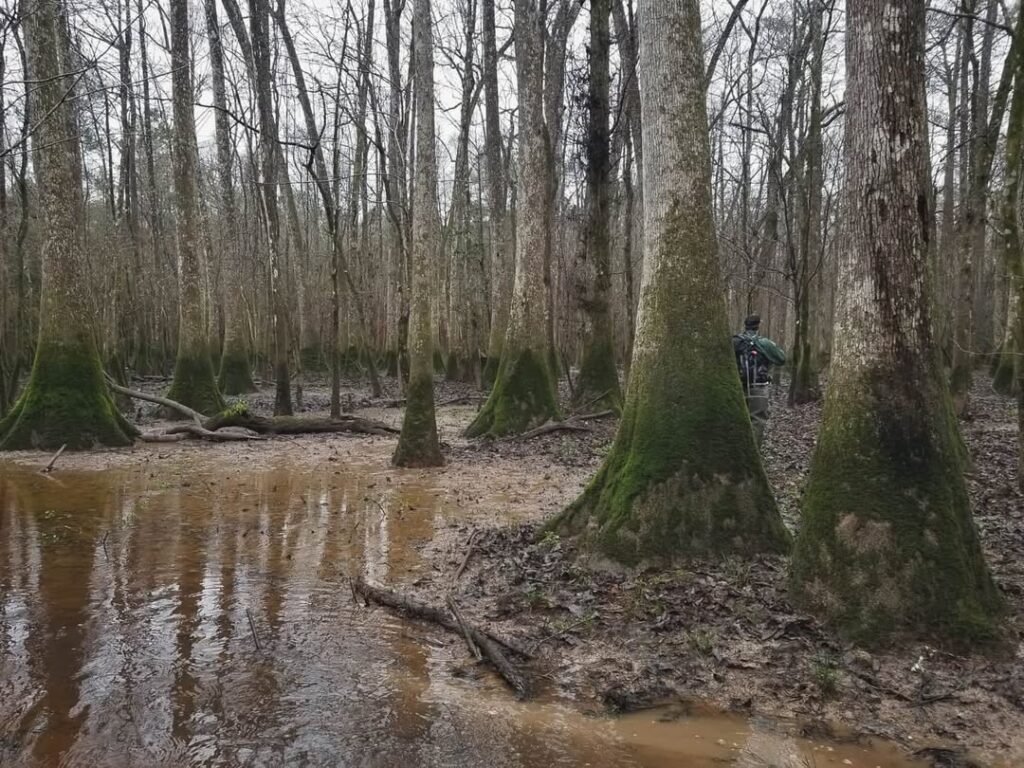
Tupelo Gum (Nyssa aquatica) stands as one of Louisiana’s most remarkable wetland trees, reaching heights of 50-100 feet with its distinctive buttressed base that tapers into a straight trunk. This obligate wetland species dominates Louisiana’s swamps and floodplain forests, forming dense canopies in cypress-tupelo associations.
Known for producing the prized tupelo honey and supporting diverse wildlife with its purple-black fruits, this deciduous tree displays large, glossy leaves and adapts remarkably to flooding conditions. The tree’s spongy wood roots have been traditionally used as cork substitutes in fishnet floats by local communities. Its light, soft wood serves various commercial purposes, while its ecological role in wetland stabilization and nutrient cycling makes it essential to Louisiana’s aquatic ecosystems.
- Hardiness: Zones 6-9, well-adapted to southeastern United States climate
- Light: Full sun to partial shade, thrives in open wetland conditions
- Water: Requires constant moisture to saturated conditions; adapted to regular flooding and anaerobic soil conditions
- Soil: Deep, freshwater wetlands; tolerates clay, muck, and periodically flooded soils with poor drainage
- Fertilizer: Generally not required; adapted to nutrient cycling in natural wetland environments
- Pest/Disease Resistance: Good resistance; few serious pest or disease issues reported
- Growth Rate: Moderate to slow growth rate in wetland conditions
Red Maple (Acer Rubrum)
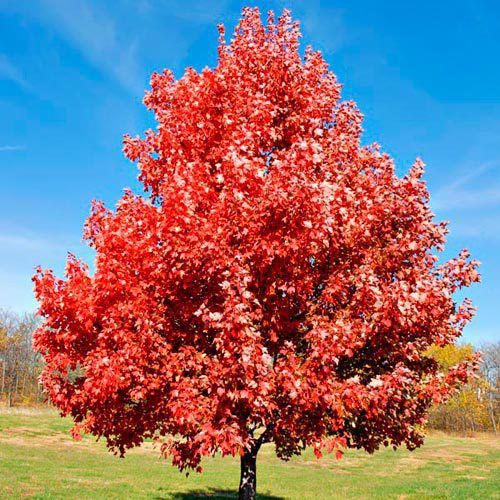
Red Maple (Acer rubrum) stands as one of Louisiana’s most recognizable and widespread deciduous trees, earning its place as a true forest guardian. This medium-sized tree creates a stunning visual display throughout the seasons with its distinctive three-lobed leaves featuring silvery undersides, bright red winter flowers, and spectacular scarlet fall foliage.
Reaching heights of up to 100 feet, Red Maple demonstrates remarkable adaptability across Louisiana’s diverse landscapes, from wetland swamps to drier upland areas. Its ecological value extends beyond beauty, providing essential habitat and food sources for wildlife while serving as a pioneer species in disturbed forest areas. The tree’s distinctive furrowed silver bark and brick red branches provide year-round visual interest even during the dormant season.
- Hardiness: USDA zones 3-9, highly adaptable to Louisiana’s climate
- Light: Full sun to partial shade, tolerates various light conditions
- Water: Moderate to high moisture needs, thrives in wet to occasionally dry soils
- Soil: Highly adaptable, grows in swampy wetlands to poor, dry soils; prefers slightly acidic conditions
- Fertilizer: Generally requires minimal fertilization in native settings; benefits from organic matter
- Pest/Disease Resistance: Generally resistant with few serious pest or disease issues
- Growth Rate: Moderate to fast, establishing quickly as a pioneer species
Resilient Native Shrub Varieties
Louisiana’s native shrubs demonstrate remarkable adaptability to challenging conditions, from flooding to drought. Key resilient varieties include Wax Myrtle, American Beautyberry, saline prairie specialists, and coastal Turtleweed. These species exhibit different wetland indicator categories that help determine their probability of occurrence in wetland versus upland environments.
American Beautyberry (Callicarpa Americana)
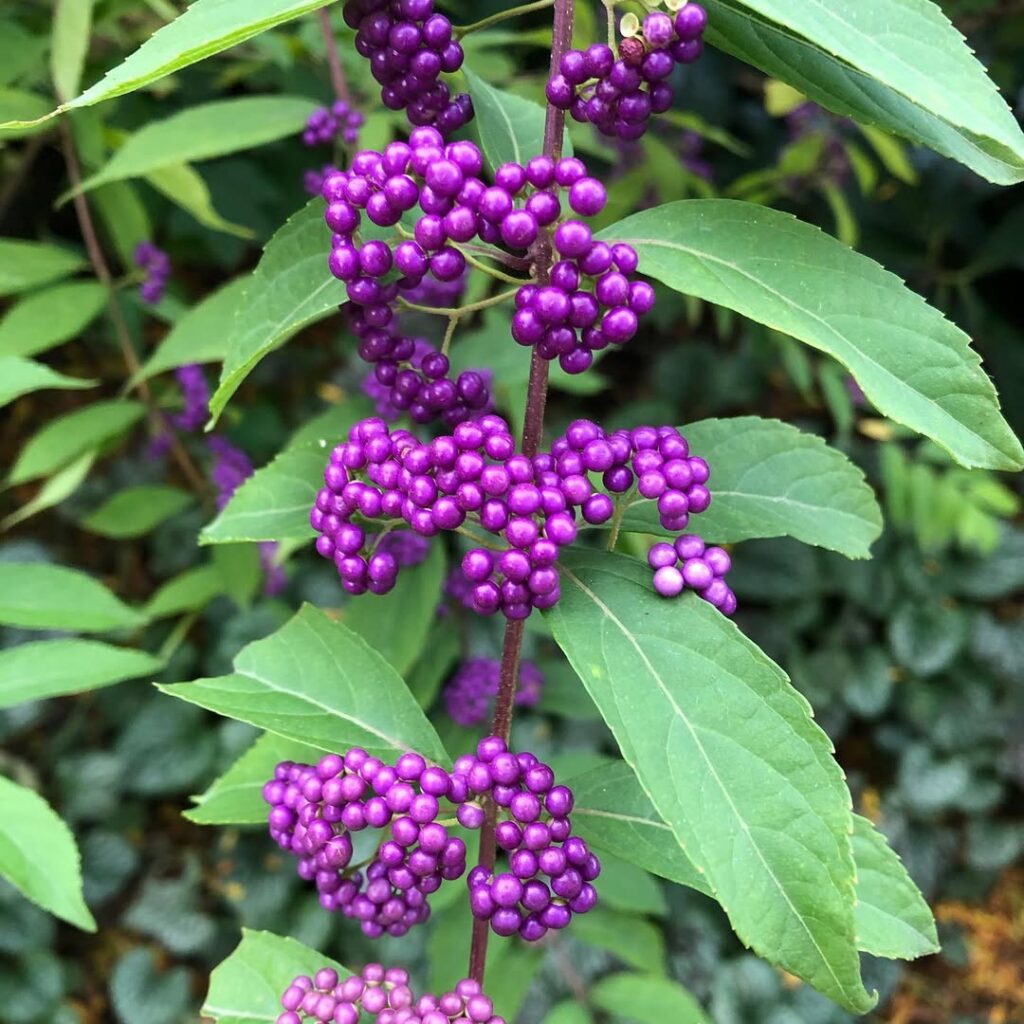
American Beautyberry is a deciduous, multistemmed shrub native to the southeastern United States that grows 3-5 feet tall and wide. This resilient understory species produces small pink to bluish tubular flowers in summer, followed by distinctive bright purple berries clustered at the nodes. The aromatic foliage naturally repels insects, while the colorful berries provide winter food for songbirds and persist well into the colder months.
Also known as French Mulberry in Louisiana, this adaptable shrub thrives in various habitats from rich bottomlands to coastal woodlands. It serves as an excellent colonizing plant in disturbed areas and contributes greatly to local biodiversity as a native component of Louisiana’s forest ecosystems. The plant has a relatively short lifespan of about 10 to 15 years, though volunteers often appear from seeds to maintain populations.
- Hardiness: USDA zones 6-10, well-adapted to southeastern climate conditions
- Light: Partial shade to full sun, naturally grows as understory species in woodlands
- Water: Moderate to high moisture needs, prefers consistently moist but well-draining soil
- Soil: Adapts to various soil types, prefers rich, organic, slightly acidic to neutral pH
- Fertilizer: Low maintenance, benefits from organic matter but doesn’t require regular feeding
- Pest/Disease Resistance: Excellent natural resistance, aromatic compounds deter many insects
- Growth Rate: Moderate to fast, establishes quickly and spreads through root suckers
Spicebush (Lindera Benzoin)

Spicebush (Lindera benzoin) is a medium-sized deciduous shrub native to Louisiana’s low woods, stream banks, and swamps. Growing 3-10 feet tall, it produces fragrant yellow flowers in early spring before leaves emerge, followed by bright red drupes in fall. The aromatic leaves turn vibrant yellow in autumn. The plant is also known by common names including Northern Spicebush, Wild Allspice, and simply Spicebush.
This resilient native serves exceptional ecological value as a host plant for Eastern Tiger Swallowtail and Spicebush Swallowtail butterflies, while providing early spring pollen for bees and food for over 24 bird species. Historically used by Native Americans for tea and as an allspice substitute, spicebush remains valuable for naturalized landscaping and restoration projects throughout the southeastern United States.
- Hardiness: Zones 4-9, well-adapted to Louisiana and southeastern U.S. conditions
- Light: Part-shade to full sun; tolerates shade but produces better form and berries in sunlight
- Water: Medium to high water use; tolerates range from dry to wet soil conditions
- Soil: Moist, rich, sandy or loamy soils with good drainage; adaptable to various moisture levels
- Fertilizer: Low maintenance; thrives in naturally fertile soils without supplemental feeding
- Pest/Disease Resistance: Excellent; exhibits little susceptibility to serious diseases or insect problems
- Growth Rate: Fast-growing and capable of natural thicket formation through root sprouting
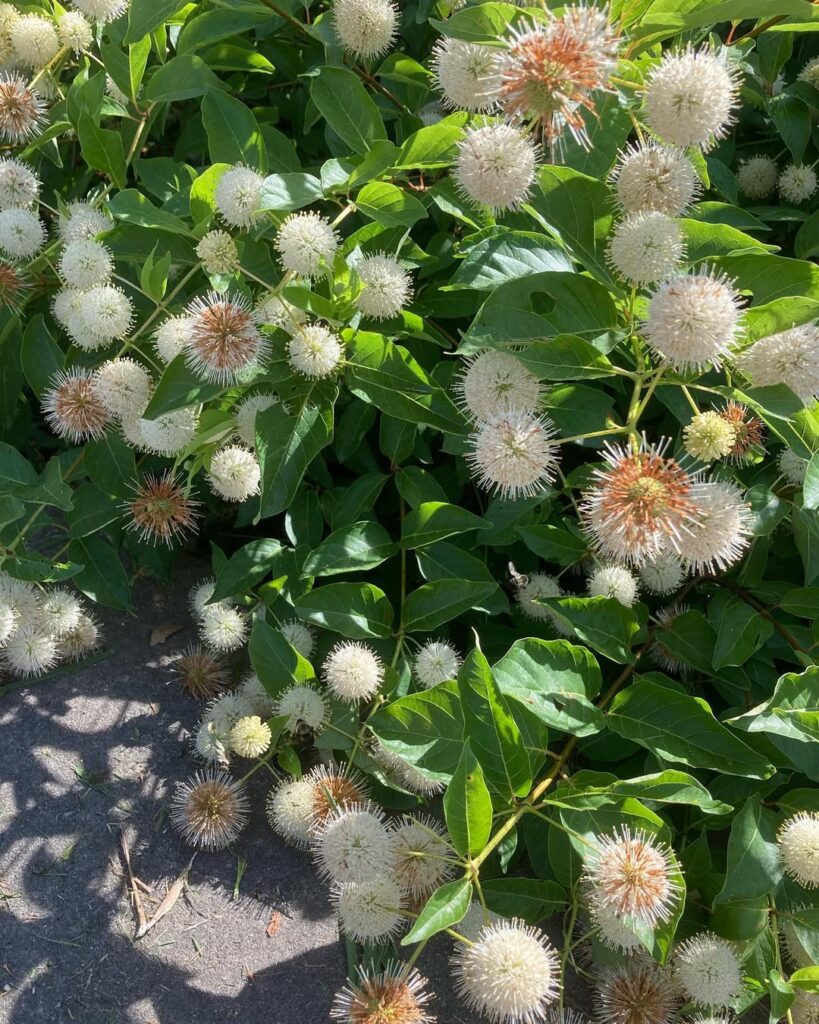
Buttonbush (Cephalanthus occidentalis) is a resilient native Louisiana shrub that thrives in wetland environments throughout the state. This large, multi-stemmed deciduous shrub typically reaches 6-12 feet tall and forms distinctive umbrella-like crowns with large, satin-finished leaves. During summer, it produces eye-catching spherical flower heads resembling ping-pong balls that serve as critical nectar sources for pollinators.
This versatile shrub excels in Louisiana’s challenging wetland conditions, tolerating periodic flooding and standing water while providing essential ecosystem services. Buttonbush offers valuable nesting platforms for wading birds like herons and egrets, while its root system helps stabilize shorelines and filter water. Its adaptability to disturbed conditions and rapid regrowth make it an excellent choice for wetland restoration projects and rain gardens. As a member of the Rubiaceae family, buttonbush shares botanical characteristics with coffee plants and gardenias, contributing to its distinctive flower structure and growth patterns.
- Hardiness: Zones 5-10, well-adapted to Louisiana’s climate
- Light: Full sun to part shade
- Water: High water requirements; tolerates standing water and periodic flooding
- Soil: Moist, humusy soils preferred; adaptable to various soil types including clay
- Fertilizer: Low requirements; thrives in natural wetland conditions
- Pest/Disease Resistance: Generally resistant with few serious issues
- Growth Rate: Moderate to fast; rapid regrowth after damage or flooding
Wax Myrtle (Morella Cerifera)
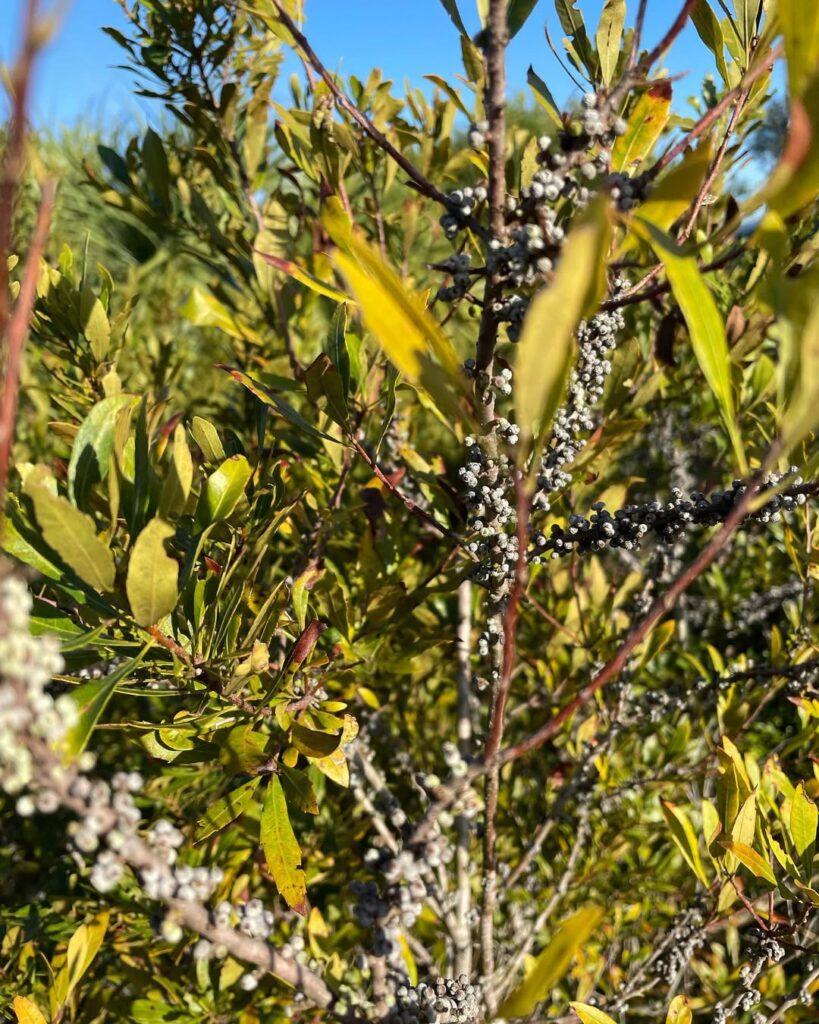
Wax Myrtle is a resilient evergreen shrub or small tree native to Louisiana’s diverse ecosystems. This adaptable plant features aromatic olive-green foliage and produces chartreuse catkins in late winter, followed by persistent pale blue waxy berries on female plants that provide winter wildlife food.
Known for its exceptional tolerance to various environmental conditions, Wax Myrtle serves as an excellent pioneer species and ornamental plant. Its ability to fix atmospheric nitrogen through root nodules and spread through underground runners makes it valuable for soil stabilization and natural succession processes. Historically, colonists utilized the waxy fruit coating to create fragrant-burning candles, giving this versatile shrub additional cultural significance.
- Hardiness: Zones 7-11, tolerates coastal storms and temperature extremes
- Light: Full sun to partial shade
- Water: Moderate to wet conditions, drought tolerant once established
- Soil: Adaptable to various soil types from wetlands to sandy environments
- Fertilizer: Minimal requirements due to nitrogen-fixing capability
- Pest/Disease Resistance: High resistance, very few pest or disease issues
- Growth Rate: Moderate to fast, spreads laterally through underground runners
Elderberry (Sambucus Canadensis)
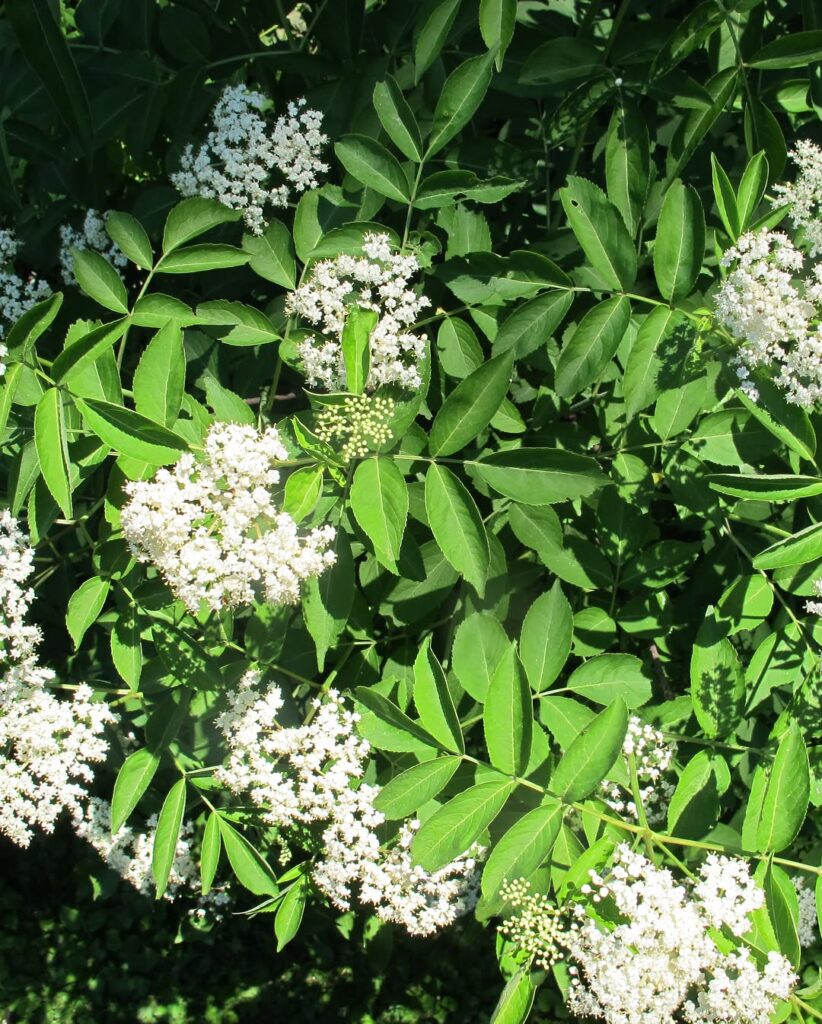
Elderberry (Sambucus canadensis) is a versatile deciduous shrub native to eastern North America, including Louisiana. This fast-growing plant reaches 5-12 feet tall with arching stems and bright green pinnate leaves. In late spring, it produces large clusters of fragrant white flowers followed by dark purple-black berries. The plant forms thickets over time and adapts well to various soil conditions.
This resilient shrub thrives in Louisiana’s diverse environments, from wetlands to upland areas. Both flowers and berries are edible and valued for their culinary and medicinal properties, though caution is needed as some plant parts contain toxic compounds. Elderberry serves as an excellent choice for naturalized landscapes and wildlife gardens. The berries attract various bird species and mammals, while deer browse on the twigs and leaves.
- Hardiness: USDA zones 4a-8b
- Light: Full sun to partial shade (2-6 hours direct sunlight)
- Water: Prefers moist to wet conditions but tolerates drought once established
- Soil: Adaptable to clay, sand, loam, and high organic matter soils; acid to neutral pH
- Fertilizer: Low to medium fertility requirements; benefits from organic matter
- Pest/Disease Resistance: Generally resistant to most pests and diseases; pollution tolerant
- Growth Rate: Fast to medium growth rate with moderate maintenance needs
Selecting the Right Native Plants for Your Garden
When you’re ready to transform your Louisiana landscape with native plants, you’ll have access to approximately 2,500 species that have already adapted to your local conditions. Your plant selection should consider USDA Cold Hardiness Zones 7-10, which cover Louisiana’s diverse regions.
Focus on disease-resistant varieties that’ll thrive in your area’s heat, humidity, and high rainfall. Group plants with similar moisture and light requirements together during garden design. Consider each plant’s mature size to prevent overcrowding later. Native plants also provide essential food and shelter for local wildlife species, supporting the biodiversity that makes Louisiana’s ecosystems unique.
Once established, these natives require less maintenance and cost less than non-native alternatives, making them perfect for sustainable Louisiana gardens.
Frequently Asked Questions
What Are the Legal Requirements for Removing Native Plants From Public Lands?
You must obtain permits from Louisiana Department of Wildlife and Fisheries and written permission from land management agencies before removing native plants from public lands, or face legal consequences under public land regulations.
How Do Native Louisiana Plants Affect Local Property Values?
Picture your home’s value blooming like Louisiana wildflowers. You’ll see property appreciation averaging 5.5% with sophisticated native landscapes, while enjoying ecological benefits that attract wildlife-loving buyers and reduce maintenance costs considerably.
Which Native Plants Are Considered Invasive in Neighboring States?
You’ll find prickly pear cactus and other Louisiana natives become invasive species in neighboring states where they lack natural predators. Their ecological impact increases when they spread uncontrollably outside their native range.
What Permits Are Needed to Sell Native Louisiana Plants Commercially?
You’ll need a Nursery Certificate Permit for commercial plant permits when selling native Louisiana species. Commercial operations require annual licensing, inspection compliance, and adherence to native species regulations for both in-state and interstate sales.
How Do Native Plants Impact Septic Systems and Underground Utilities?
Trees require 20-50 foot distances from septic systems depending on species. You’ll find native plant benefits include shallow-rooted grasses and perennials that won’t damage pipes, while septic system interactions remain minimal with proper selection.
